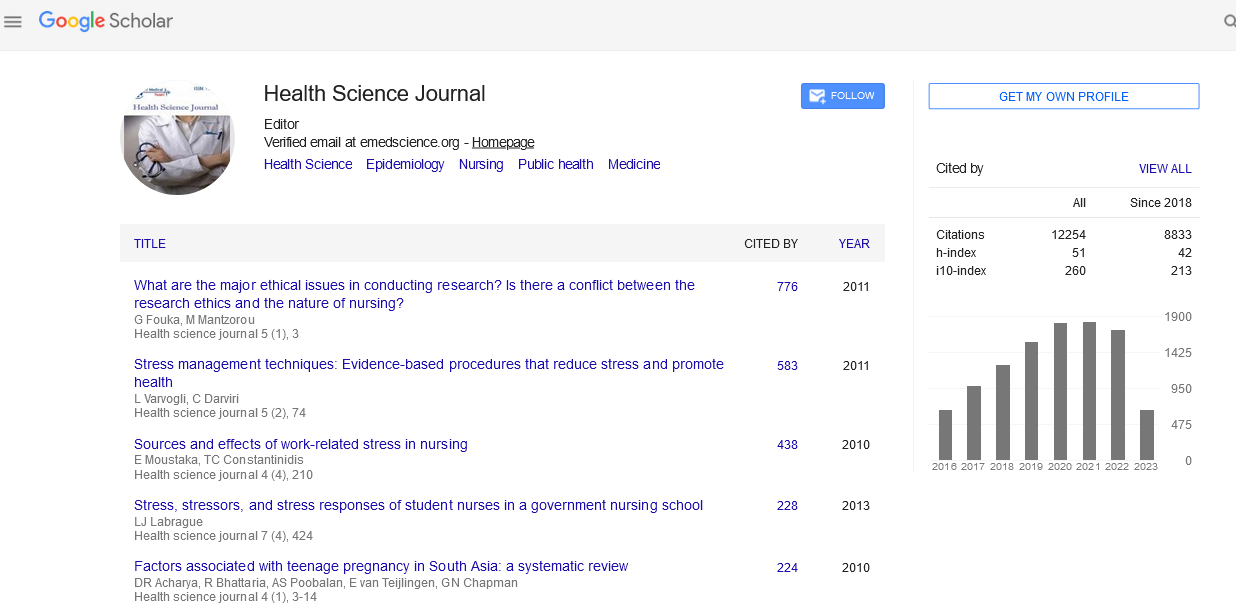Editorial - (2025) Volume 19, Issue 1
Genetic Susceptibility and Environmental Triggers in the Onset of Type 1 Diabetes: A Twin Study
Yuki Nishida*
Department of Health Science, University of Copenhagen, Denmark
*Correspondence:
Yuki Nishida, Department of Health Science, University of Copenhagen,
Denmark,
Email:
Received: 01-Jan-2025, Manuscript No. Iphsj-25-15516;
Editor assigned: 04-Jan-2025, Pre QC No. Iphsj-25-15516 (PQ);
Reviewed: 16-Jan-2025, QC No. Iphsj-25-15516;
Revised: 21-Jan-2025, Manuscript No. Iphsj-25-15516 (R);
Published:
30-Jan-2025, DOI: 10.36648/1791-809X.19.1.1217
Introduction
Type 1 diabetes (T1D) is a chronic autoimmune disorder characterized by the destruction of insulin-producing β-cells in the pancreas. While the etiology of T1D is multifactorial [1], the interplay between genetic susceptibility and environmental factors is pivotal in determining the onset of the disease. Genetic factors are thought to account for approximately 50% of the risk for developing T1D [2], with environmental triggers playing a crucial role in disease manifestation. This article explores the contribution of genetic susceptibility and environmental triggers to the onset of T1D through a twin study framework, aiming to elucidate how these factors interact in the pathogenesis of the disease [3].
Genetic Factors in Type 1 Diabetes
Genetic susceptibility to T1D is strongly linked to the major histocompatibility complex (MHC) located on chromosome 6. The most notable genetic marker associated with T1D is the human leukocyte antigen (HLA) class II region, particularly the DR and DQ alleles [4]. The presence of certain alleles, such as HLA-DR3 and HLA-DR4, increases the risk of developing T1D. However, not all individuals with these alleles will develop the disease, suggesting that genetic susceptibility alone is insufficient for disease onset. In addition to the HLA region, numerous non-HLA genes have been implicated in T1D risk. These include genes involved in immune regulation, such as those encoding for interleukins, co-stimulatory molecules, and cytokine receptors. Polymorphisms in the insulin gene (INS) on chromosome 11 are also associated with an increased risk of T1D, potentially by influencing the expression of insulin itself, which plays a role in the development of autoimmunity [5]. Studies of monozygotic (MZ) twins, who share nearly 100% of their genetic material, provide compelling evidence for the genetic contribution to T1D. The concordance rate for T1D in MZ twins is significantly higher compared to dizygotic (DZ) twins, suggesting a substantial genetic component. However, the concordance rate is not 100%, indicating that environmental factors also play a significant role in the disease onset.
Environmental Triggers in Type 1 Diabetes
While genetic susceptibility provides the foundation for T1D development, environmental factors are crucial in triggering the autoimmune response that leads to the destruction of pancreatic β-cells [6]. The environmental triggers for T1D are diverse and remain a subject of ongoing research. Several factors have been proposed, including viral infections, dietary influences, and environmental toxins. Viral infections, particularly those caused by enteroviruses such as coxsackievirus B and rubella have been implicated in the onset of T1D. It is hypothesized that viral infections may initiate autoimmune processes by molecular mimicry, where viral proteins resemble β-cell antigens, leading the immune system to attack the pancreas. Studies have shown that children who experience certain viral infections early in life have an increased risk of developing T1D, although not all viral infections result in the disease. Dietary factors are another key environmental trigger in T1D development. Early exposure to cow’s milk protein, particularly in genetically predisposed infants, has been suggested to increase the risk of developing T1D. Conversely, breast-feeding and delayed introduction of solid foods are believed to provide protective effects. The role of vitamin D deficiency in the development of T1D has also been studied, with low levels of vitamin D potentially influencing immune dysregulation and promoting β-cell autoimmunity.
Environmental toxins, such as those found in pesticides and heavy metals, may also contribute to T1D onset. Some studies suggest that exposure to these toxins can alter immune function or trigger autoimmune processes, particularly in genetically predisposed individuals. However, the evidence for environmental toxins as direct causes of T1D remains inconclusive and warrants further investigation.
Twin Studies and Genetic-Environmental Interactions
Twin studies are an invaluable tool for exploring the relative contributions of genetic and environmental factors to the onset of complex diseases like T1D. By comparing the concordance rates for T1D in MZ and DZ twins, researchers can assess the heritability of the disease and gain insights into the environmental factors that may influence its onset. In MZ twins, where the genetic background is nearly identical, any discordance in disease development suggests the involvement of environmental factors. In the context of T1D, twin studies have shown that while the concordance rate for MZ twins is higher than that for DZ twins, it is far from 100%, indicating that environmental factors play a crucial role in disease expression. The difference in concordance rates between MZ and DZ twins can be attributed to genetic differences as well as environmental exposures. The discordance observed in MZ twins has led to the hypothesis that environmental triggers, such as viral infections, diet, and autoimmune responses, are critical in determining whether T1D will develop. One notable study that examined the genetic and environmental factors influencing T1D in twins found that the presence of a specific viral infection in one twin could trigger the onset of the disease, even if the other twin, with the same genetic background, remained unaffected. This finding underscores the importance of environmental factors in disease expression. Additionally, studies have shown that twins who were reared apart but both developed T1D still shared genetic risk factors, highlighting the significant role of genetics in predisposition to the disease.
The Role of Epigenetics in Type 1 Diabetes
Epigenetics provides a framework for understanding how environmental factors can modify gene expression without altering the underlying DNA sequence. In T1D, epigenetic modifications may play a key role in how environmental triggers influence the autoimmune response. For example, environmental factors such as viral infections, diet, and toxins may induce changes in DNA methylation, histone modification, or non-coding RNA expression, all of which could affect immune system regulation and β-cell survival. Recent studies have suggested that epigenetic changes may contribute to the development of T1D in genetically predisposed individuals, potentially offering insights into how environmental exposures during early life could lead to disease onset. However, the role of epigenetics in T1D remains an area of active research, and further studies are needed to establish clear links between environmental exposures and epigenetic modifications in the pathogenesis of T1D.
Conclusion
The onset of type 1 diabetes is the result of a complex interplay between genetic susceptibility and environmental triggers. While genetic factors, particularly those related to the HLA region, are strongly associated with increased risk, the role of environmental factors such as viral infections, dietary influences, and toxins is equally crucial in the development of the disease. Twin studies have provided valuable insights into the genetic and environmental contributions to T1D, revealing that the discordance in disease onset among monozygotic twins is largely due to environmental exposures. Additionally, emerging evidence suggests that epigenetic modifications may mediate the effects of environmental triggers on gene expression and immune function. Understanding the genetic-environmental interactions that contribute to the onset of T1D is essential for the development of targeted prevention strategies and therapeutic interventions for those at risk of this autoimmune disorder.
References
- Boumba V, Ziavrou K, Vougiouklakis T (2006) Hair as a biological indicator of drug use, drug abuse or chronic exposure to environmental toxicants. Int J Tox 25: 143-163.
Indexed at, Google Scholar, Crossref
- Cappella A, Bertoglio B, Di Maso M, Mazzarelli D, Affatato L et al.(2022) Sexual Dimorphism of Cranial Morphological Traits in an Italian Sample: A Population-Specific Logistic Regression Model for Predicting Sex. Biology 11: 1202.
Google Scholar, Crossref
- Harris JE, Eng JJ (2006) Individuals with the dominant hand affected following stroke demonstrate less impairment than those with the no dominant hand affected. Neuro rehabilitation and neural repair 20: 380-389.
Google Scholar, Crossref
- Hitchhiker’s Thumb (Distal Hyperextensibility): Symptoms, Causes & Outlook. (n.d.). Retrieved December 8.
Google Scholar
- Inzinger M, Massone C, Arzberger E, Hofmann-Wellenhof R (2013) Hair repigmentation in melanoma. The Lancet 382: 1224.
Google Scholar, Crossref
- Bakan P, Dibb G, Reed P (1973) Handedness and birth stress. Neuropsychologia 11: 363-366.
Indexed at, Google Scholar, Crossref
Citation: Nishida Y (2024) Genetic Susceptibility and Environmental Triggers in the Onset of Type 1 Diabetes: A Twin Study. Health Sci J. Vol. 19 No. 1: 1217.





